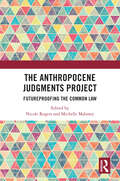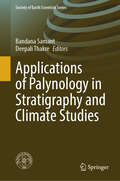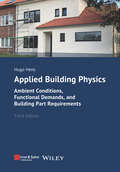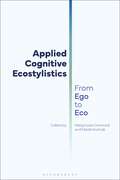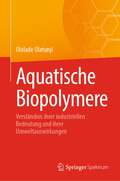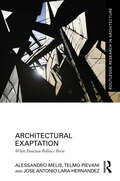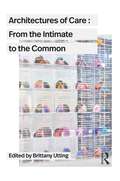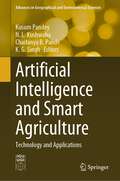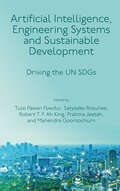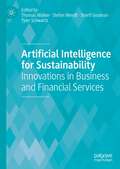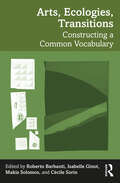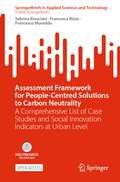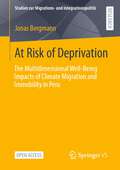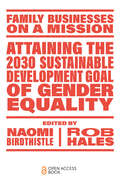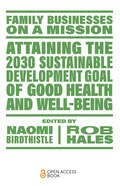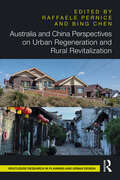- Table View
- List View
The Anthropocene Judgments Project: Futureproofing the Common Law
by Nicole Rogers and Michelle MaloneyThis book is a collection of speculative judgments that, along with accompanying commentaries, pursue a novel enquiry into how judges might respond to the formidable and planetary-scaled challenges of the Anthropocene. The book’s contributors –from Australia, Asia, Europe, and the United Kingdom –take up a range of issues: including multispecies justice, the challenges of intergenerational justice, dimensions of postcolonial justice, the potential contribution of AI platforms to the judgment process, and the future of judging and law in and beyond the Anthropocene. The project takes its inspiration from existing critical judgment projects. It is, however, thoroughly interdisciplinary. In anticipating future scenarios, and designing or adapting legal principles to respond to them, the book’s contributors have been assisted by climate scientists with expertise in future modelling; they have benefitted from the experience of fiction writers in future worldbuilding; and they have incorporated elements of the future worlds depicted in various texts of speculative fiction and artworks. The judgments are, of necessity, speculative and hypothetical in their subject matter. Thus, taken together, they constitute a collaborative experiment in creating the inclusive and radical imaginaries of the future common law. The Anthropocene Judgments Project will appeal to critical and sociolegal academics, scholars in the environmental humanities, environmental lawyers, students, and others with interests in the pressing issues of ecology, multispecies justice, climate change, the intersection of AI platforms and the law, and the future of law in the Anthropocene.
The Anthropocene Judgments Project: Futureproofing the Common Law
This book is a collection of speculative judgments that, along with accompanying commentaries, pursue a novel enquiry into how judges might respond to the formidable and planetary-scaled challenges of the Anthropocene. The book’s contributors –from Australia, Asia, Europe, and the United Kingdom –take up a range of issues: including multispecies justice, the challenges of intergenerational justice, dimensions of postcolonial justice, the potential contribution of AI platforms to the judgment process, and the future of judging and law in and beyond the Anthropocene. The project takes its inspiration from existing critical judgment projects. It is, however, thoroughly interdisciplinary. In anticipating future scenarios, and designing or adapting legal principles to respond to them, the book’s contributors have been assisted by climate scientists with expertise in future modelling; they have benefitted from the experience of fiction writers in future worldbuilding; and they have incorporated elements of the future worlds depicted in various texts of speculative fiction and artworks. The judgments are, of necessity, speculative and hypothetical in their subject matter. Thus, taken together, they constitute a collaborative experiment in creating the inclusive and radical imaginaries of the future common law. The Anthropocene Judgments Project will appeal to critical and sociolegal academics, scholars in the environmental humanities, environmental lawyers, students, and others with interests in the pressing issues of ecology, multispecies justice, climate change, the intersection of AI platforms and the law, and the future of law in the Anthropocene.
Applications of Palynology in Stratigraphy and Climate Studies (Society of Earth Scientists Series)
by Bandana Samant Deepali ThakreThis book highlights the importance of palynology in understanding floral biodiversity, paleoclimate and depositional environments in deep time and recent sediments. It includes contributions from renowned Indian palynologists who work on the applied aspects of palynology. The book focuses on the significance of palynology in solving various geological problems, ranging from the Precambrian to the Recent. This book will be useful to graduate and postgraduate students, researchers, and academicians working in geology and botany, as well as international researchers interested in palynological research work in India.
Applied Building Physics: Ambient Conditions, Functional Demands, and Building Part Requirements
by Hugo S. HensWhile the first volume on building physics deals with the physical principles of heat, air and moisture behaviour of buildings, building structures and components, this second volume on applied building physics focuses on the question of what the desired performance of buildings consists of. To achieve this, knowledge of the external environmental effects and the internal live loads to which buildings are subjected is a necessary first step. Subsequently, the performance requirements and the physical correspondences are deepened with the determination of their physical parameters, at the levels of buildings, building structures and building components. Compared to the second edition, the discussion of criteria is not limited to thermal comfort, but also includes acoustic, visual and olfactory aspects. Likewise, the indoor air quality is considered in a broader way. Analyses and calculations result in sustainable buildings with a comfortable indoor climate from functional and durable building constructions. Compared to the second edition, the text for the third edition has been reorganised, corrected, revised and expanded where appropriate. A useful appendix for quick reference contains standard values of material properties for a wide range of building materials. The analyses and calculations described in this book result in sustainable buildings made of functional and durable building constructions, with comfortable and healthy indoor climate and air quality. Compared to the second edition the text in this third edition has been reshuffled, corrected, reworked and extended where appropriate.
Applied Building Physics: Ambient Conditions, Functional Demands, and Building Part Requirements
by Hugo S. HensWhile the first volume on building physics deals with the physical principles of heat, air and moisture behaviour of buildings, building structures and components, this second volume on applied building physics focuses on the question of what the desired performance of buildings consists of. To achieve this, knowledge of the external environmental effects and the internal live loads to which buildings are subjected is a necessary first step. Subsequently, the performance requirements and the physical correspondences are deepened with the determination of their physical parameters, at the levels of buildings, building structures and building components. Compared to the second edition, the discussion of criteria is not limited to thermal comfort, but also includes acoustic, visual and olfactory aspects. Likewise, the indoor air quality is considered in a broader way. Analyses and calculations result in sustainable buildings with a comfortable indoor climate from functional and durable building constructions. Compared to the second edition, the text for the third edition has been reorganised, corrected, revised and expanded where appropriate. A useful appendix for quick reference contains standard values of material properties for a wide range of building materials. The analyses and calculations described in this book result in sustainable buildings made of functional and durable building constructions, with comfortable and healthy indoor climate and air quality. Compared to the second edition the text in this third edition has been reshuffled, corrected, reworked and extended where appropriate.
Applied Cognitive Ecostylistics: From Ego to Eco
by Malgorzata Drewniok, Marek Kuźniak, andThis book offers an up-to-date account of one of the most influential strands of eco-research: cognitive ecostylistics. The onset of the 1970s saw a global shift in scholarly perspective upon the relation between egocentric and ecocentric views of the world. The so-called eco-turn was not only linguistic at its roots, but engaged the bulk of academic thought in social sciences and humanities. Cognitive ecostylistics invites a multidisciplinary approach to the study of the conceptual relations between oral or written texts and their impact on the environment. This volume is a collection of the latest research that seeks to apply the theory and methodology developed over the last 40 years to both literary and real-life texts, engaging with a wealth of examples from First World War poetry and Anne of Green Gables through to Condé Nast Traveller hotel descriptions. Exploring the cultural effects of the eco-turn, the collection engages the reader in the problem of the present-day Anthropocene, manifested as Ego-Eco tensions at the level of communicating self-needs and the needs of the Other. Divided into two parts, it considers first the human-angled semiotic interplay contained within the universe of people, before examining the problem of semiotic engagement of texts as extraneous to the human, highlighting crucial aspects of nature, culture, and beyond.
Aquatische Biopolymere: Verständnis ihrer industriellen Bedeutung und ihrer Umweltauswirkungen
by Ololade OlatunjiDieses Buch gibt einen umfassenden Überblick über die jüngsten Entwicklungen bei industriellen Anwendungen, Verarbeitungstechniken und Modifikationen von Polymeren aus marinen Quellen. Es führt den Leser systematisch in die Biomaterialien Chitin, Kollagen, Alginate, Cellulose und Polyester ein und stellt eine Verbindung zwischen ihrer industriellen Bedeutung und ihren Auswirkungen auf die Umwelt her. Das Buch verdeutlicht die Auswirkungen der industriellen Nutzung des aquatischen Systems für organische und anorganische Stoffe auf die Umwelt und vertieft das Verständnis der industriellen und wirtschaftlichen Bedeutung aquatischer Biopolymere. Darüber hinaus geht es um die Frage, wie die Erhaltung des aquatischen Lebens und das industrielle und wirtschaftliche Interesse an der Entwicklung biologisch abbaubarer Alternativen für Kunststoffe in Einklang gebracht werden können. Das Buch richtet sich daher an Wissenschaftler:innen aus den Bereichen Chemie, Material- und Polymerwissenschaften sowie Ingenieurwesen.
Architectural Exaptation: When Function Follows Form (Routledge Research in Architecture)
by Alessandro Melis Telmo Pievani Jose Antonio Lara-HernandezArchitectural Exaptation: When Function Follows Form focuses on the significance and the originality of the study of exaptation. It presents exaptation as an opportunity to extend architectural design towards more sustainable approaches aimed at enforcing urban resilience.The use of exaptation’s definition in architecture supports the heuristic value of cross-disciplinary studies on biology and architecture, which seem even more relevant in times of global environmental crises. This book aims to make a critique of the pre-existing and extensive paternalistic literature. Exaptation will be described as a functional shift of a structure that already had a prior, but different, function. In architecture, a functional shift of a structure that already had a function may apply to forms of decorative elements embedded in architectural components, and to both change of function of tectonic elements and the change of use of an architectural space. The book is illustrated with examples from around the globe, including China, Italy, Mexico, New Zealand, the USA and the UK, and looks at different civilizations and diverse historical periods, ranging from the urban to the architectural scale. Such examples highlight the potential and latent human creative capacity to change the use and functions, something that cities and buildings could consider when facing disturbances. Exaptation is shown as an alternative narrative to the simplifications of evolutionary puritanism. It also offers an innovative perspective and presents an opportunity to re-think the manner in which we design and redesign our cities.This book will be of interest to architecture, planning, urban design and biology researchers and students.
Architectural Exaptation: When Function Follows Form (Routledge Research in Architecture)
by Alessandro Melis Telmo Pievani Jose Antonio Lara-HernandezArchitectural Exaptation: When Function Follows Form focuses on the significance and the originality of the study of exaptation. It presents exaptation as an opportunity to extend architectural design towards more sustainable approaches aimed at enforcing urban resilience.The use of exaptation’s definition in architecture supports the heuristic value of cross-disciplinary studies on biology and architecture, which seem even more relevant in times of global environmental crises. This book aims to make a critique of the pre-existing and extensive paternalistic literature. Exaptation will be described as a functional shift of a structure that already had a prior, but different, function. In architecture, a functional shift of a structure that already had a function may apply to forms of decorative elements embedded in architectural components, and to both change of function of tectonic elements and the change of use of an architectural space. The book is illustrated with examples from around the globe, including China, Italy, Mexico, New Zealand, the USA and the UK, and looks at different civilizations and diverse historical periods, ranging from the urban to the architectural scale. Such examples highlight the potential and latent human creative capacity to change the use and functions, something that cities and buildings could consider when facing disturbances. Exaptation is shown as an alternative narrative to the simplifications of evolutionary puritanism. It also offers an innovative perspective and presents an opportunity to re-think the manner in which we design and redesign our cities.This book will be of interest to architecture, planning, urban design and biology researchers and students.
Architectures of Care: From the Intimate to the Common
Drawing from a diverse range of interdisciplinary voices, this book explores how spaces of care shape our affective, material, and social forms, from the most intimate scale of the body to our planetary commons.Typical definitions of care center around the maintenance of a livable life, encompassing everything from shelter and welfare to health and safety. Architecture plays a fundamental role in these definitions, inscribed in institutional archetypes such as the home, the hospital, the school, and the nursery. However, these spaces often structure modes of care that prescribe gender roles, bodily norms, and labor practices. How can architecture instead engage with an expanded definition of care that questions such roles and norms, producing more hybrid entanglements between our bodies, our collective lives, and our environments? Chapters in this book explore issues ranging from disabled domesticities and nursing, unbuilding whiteness in the built environment, practices and pedagogies of environmental care, and the solidarity networks within ‘The Cloud’. Case studies include Floating University Berlin, commoning initiatives by the Black Panther party, and hospitals for the United Mine Workers of America, among many other sites and scales of care.Exploring architecture through the lenses of gender studies, labor theory, environmental justice, and the medical humanities, this book will engage students and academics from a wide range of disciplines.
Architectures of Care: From the Intimate to the Common
by Brittany UttingDrawing from a diverse range of interdisciplinary voices, this book explores how spaces of care shape our affective, material, and social forms, from the most intimate scale of the body to our planetary commons.Typical definitions of care center around the maintenance of a livable life, encompassing everything from shelter and welfare to health and safety. Architecture plays a fundamental role in these definitions, inscribed in institutional archetypes such as the home, the hospital, the school, and the nursery. However, these spaces often structure modes of care that prescribe gender roles, bodily norms, and labor practices. How can architecture instead engage with an expanded definition of care that questions such roles and norms, producing more hybrid entanglements between our bodies, our collective lives, and our environments? Chapters in this book explore issues ranging from disabled domesticities and nursing, unbuilding whiteness in the built environment, practices and pedagogies of environmental care, and the solidarity networks within ‘The Cloud’. Case studies include Floating University Berlin, commoning initiatives by the Black Panther party, and hospitals for the United Mine Workers of America, among many other sites and scales of care.Exploring architecture through the lenses of gender studies, labor theory, environmental justice, and the medical humanities, this book will engage students and academics from a wide range of disciplines.
Artificial Intelligence and Smart Agriculture: Technology and Applications (Advances in Geographical and Environmental Sciences)
by Kusum Pandey N. L. Kushwaha Chaitanya B. Pande K. G. SinghAs technology continues to saturate modern society, agriculture has started to adopt digital computing and data-driven innovations. This emergence of “smart” farming has led to various advancements in the field, including autonomous equipment and the collection of climate, livestock, and plant data. As connectivity and data management continue to revolutionize the farming industry, empirical research is required to understand these technological developments. This book explores the applications of various artificial intelligence techniques by identifying and describing technical, functional, and non-functional future technologies for smart farming and agriculture. The book also presents practical application opportunities for the resolution of real-world problems, including contributions from precision irrigation, greenhouse data, livestock monitoring, automation, IoT ecosystems for agriculture, cloud computing, mobile robots for precision agriculture, remote sensing applications, anddata mining. In addition, this book provides summary information about different soilless techniques such as hydroponics, aeroponics, and aquaponics, among others. This book is ideally designed for farmers, agriculturalists, product managers, farm holders, manufacturers, equipment suppliers, industrialists, governmental professionals, researchers, academicians, and students seeking current research on technological applications within agriculture and farming.
Artificial Intelligence, Engineering Systems and Sustainable Development: Driving the UN SDGs
by Tulsi Pawan Fowdur, Satyadev Rosunee, Robert T. F. Ah King, Pratima Jeetah and Mahendra GooroochurnDevelopment in any country is impossible if reliable and affordable energy, safe water and sanitation, as well as telecommunication facilities, are not easily accessible. Artificial intelligence and machine learning techniques are now widely used in all branches of engineering to build and optimize systems. The combination of AI and engineering can indeed act as a real catalyst to achieve the UN SDGs. The volume editors present an analysis of different concepts and case studies in engineering disciplines such as chemical, civil, electrical, telecommunications and mechanical engineering, demonstrating how engineering systems and processes can leverage the power of AI to drive and achieve the UN SDGs. Topics covered include sustainable crop production and consumption, AI based clean water and sanitation monitoring, intelligent transport systems and achieving affordable and clean energy through AI and 5G powered internet of energy. Such a study is of paramount importance and is a valuable source of information for researchers, engineers, and policy makers to be able to better design and adopt AI enabled techniques in different engineering areas, with a view to catalyze the achievement of the UN SDGs.
Artificial Intelligence, Engineering Systems and Sustainable Development: Driving the UN SDGs
by Tulsi Pawan Fowdur Satyadev Rosunee Robert T. F. Ah King Pratima Jeetah Mahendra GooroochurnDevelopment in any country is impossible if reliable and affordable energy, safe water and sanitation, as well as telecommunication facilities, are not easily accessible. Artificial intelligence and machine learning techniques are now widely used in all branches of engineering to build and optimize systems. The combination of AI and engineering can indeed act as a real catalyst to achieve the UN SDGs. The volume editors present an analysis of different concepts and case studies in engineering disciplines such as chemical, civil, electrical, telecommunications and mechanical engineering, demonstrating how engineering systems and processes can leverage the power of AI to drive and achieve the UN SDGs. Topics covered include sustainable crop production and consumption, AI based clean water and sanitation monitoring, intelligent transport systems and achieving affordable and clean energy through AI and 5G powered internet of energy. Such a study is of paramount importance and is a valuable source of information for researchers, engineers, and policy makers to be able to better design and adopt AI enabled techniques in different engineering areas, with a view to catalyze the achievement of the UN SDGs.
Artificial Intelligence for Sustainability: Innovations in Business and Financial Services
by Thomas Walker Stefan Wendt Sherif Goubran Tyler SchwartzIn light of the climate crisis, businesses are expected to embrace sustainability to reduce their negative impacts on the environment and society, while at the same time strengthening their organisations’ positive impacts. Managing this alongside the traditional requirements of business requires careful handling, and it is small wonder that some are heralding the advantages posed by artificial intelligence (AI) as the missing piece of the puzzle. This edited book aims to present a balanced discussion of the benefits and costs of using AI for the natural environment and society, including an analysis of its potential to help meet the UN’s Agenda 2030 and the Sustainable Development Goals. Researchers, practitioners, regulators, and entrepreneurs at the forefront of sustainable AI solutions share insights into the different sustainable applications of AI and highlight how these new developments may affect and contribute to our fight against climate change and address further environmental and social challenges. This volume will be of great interest to scholars and students of digital business and new technologies, sustainability, and strategy.
Arts, Ecologies, Transitions: Constructing a Common Vocabulary
by Roberto Barbanti Isabelle Ginot Makis Solomos Cécile SorinArts, Ecologies, Transitions provides in-depth insights into how aesthetic relations and current artistic practices are fundamentally ecological and intrinsically connected to the world. As art is created in a given historic temporality, it presents specific modalities of productive and sensory relations to the world. With contributions from 49 researchers, this book tracks evolutions in the arts that demonstrate an awareness of the environmental, economic, social, and political crises. It proposes interdisciplinary approaches to art that clarify the multiple relationships between art and ecology through an exploration of key concepts such as collapsonauts, degrowth, place, recycling, and walking art. All the artistic fields are addressed from the visual arts, theatre, dance, music and sound art, cinema, and photography – including those that are rarely represented in research such as digital creation or graphic design – to showcase the diversity of artistic practices in transition.Through original research this book presents ideas in an accessible format and will be of interest to students and researchers in the fields of environmental studies, ecology, geography, cultural studies, architecture, performance studies, visual arts, cinema, music, and literature studies.
Arts, Ecologies, Transitions: Constructing a Common Vocabulary
Arts, Ecologies, Transitions provides in-depth insights into how aesthetic relations and current artistic practices are fundamentally ecological and intrinsically connected to the world. As art is created in a given historic temporality, it presents specific modalities of productive and sensory relations to the world. With contributions from 49 researchers, this book tracks evolutions in the arts that demonstrate an awareness of the environmental, economic, social, and political crises. It proposes interdisciplinary approaches to art that clarify the multiple relationships between art and ecology through an exploration of key concepts such as collapsonauts, degrowth, place, recycling, and walking art. All the artistic fields are addressed from the visual arts, theatre, dance, music and sound art, cinema, and photography – including those that are rarely represented in research such as digital creation or graphic design – to showcase the diversity of artistic practices in transition.Through original research this book presents ideas in an accessible format and will be of interest to students and researchers in the fields of environmental studies, ecology, geography, cultural studies, architecture, performance studies, visual arts, cinema, music, and literature studies.
Assessment Framework for People-Centred Solutions to Carbon Neutrality: A Comprehensive List of Case Studies and Social Innovation Indicators at Urban Level (SpringerBriefs in Applied Sciences and Technology)
by Sabrina Bresciani Francesca Rizzo Francesco MuredduThis open access book presents a catalogue of over one thousand indicators which can be used by cities' public administrators to monitor and evaluate social innovation action plans to support people-centred, collaborative or co-designed solutions to lower carbon emissions. Indicators are clustered according to a framework of social innovation solutions for climate neutrality at city level, developed by merging top-down academic knowledge with bottom-up pragmatic case studies. There is currently limited guidance on how to embed social innovations in their cities’ action plans with the aim of reaching climate neutrality, and on how to assess the progress and impacts of such people-centred projects in cities. The book addresses this gap and is thus relevant for scholars in the field of policy-making and design, as well as cities’ transition teams, policymakers and consultants. Based on the work developed within the EU-funded project NetZeroCities, intervention logics are provided for each of the ten categories of action, with related indicators clustered by category and evaluation criteria (effectiveness, efficiency, relevance, replicability, and scalability). Guidelines to implement the framework support city administrators in defining steps they need to follow to apply the indicators to their local case, making social innovation a crucial lever for accelerating systemic transformation.
At Risk of Deprivation: The Multidimensional Well-Being Impacts of Climate Migration and Immobility in Peru (Studien zur Migrations- und Integrationspolitik)
by Jonas BergmannThis open access book examines how and why various forms of climate (im)mobilities can impact people's objective and subjective well-being. Worsening climate impacts are forcing subsistence farmers worldwide to decide between staying or leaving their homes. This mixed methods study analyzes cases of climate-related migration, displacement, relocation, and immobility in Peru's coastal, highland, and rainforest regions. The results reveal that numerous farmers experienced profound and often negative well-being impacts, regardless of whether they stayed or migrated. The higher the structural constraints, such as weak governance, and the more damaging the climate impacts were, the higher the risk of well-being declines. Additionally, the affected individuals often had limited agency and ability to mitigate losses. These findings challenge the notion of "migration as adaptation" and emphasize the importance of safeguarding the human rights and security of those affected while addressing loss and damage. Without significant investments in such efforts, climate impacts could sharply diminish the well-being of numerous subsistence farmers worldwide—irrespective of whether they stay or migrate.
Attaining the 2030 Sustainable Development Goal of Gender Equality (Family Businesses on a Mission)
by NAOMI BIRDTHISTLE AND ROB HALESThe ebook edition of this title is Open Access and freely available to read online. Attaining the 2030 Sustainable Development Goal of Gender Equality focuses on Sustainable Development Goal number five (SDG#5): ending all forms of discrimination against women and girls. Examining family businesses in Honduras, Australia, Austria, and Lebanon, each case study presents a unique perspective from their respective country, analysing how SDG#5 translates into empowering women and girls around the world. The case studies presented generate insights and key takeaways into the role of family businesses in eliminating violence and other harmful practices as well as ensuring equal opportunities and participation for women in business and beyond. The United Nations’ (UN) Sustainable Development Goals (SDGs) are 17 Goals pledged by 193 nations in 2015 which would help engender an improved, fairer, and more sustainable world – one in which ‘no one is left behind’. The SDGs are a call to action, to develop innovative solutions to the most complex, societal, and environmental global challenges. In Family Businesses on a Mission, series editors Naomi Birdthistle and Rob Hales bring together international case studies to illustrate how family businesses can attain the UN 2030 SDGs. Accessible to those working in the field beyond academia – such as family business practitioners, family business owners, government and policymakers, members of NGOs, business associations and philanthropic centres – this book series equally appeals to those with a general interest in entrepreneurship and business.
Attaining the 2030 Sustainable Development Goal of Gender Equality (Family Businesses on a Mission)
by Naomi Birdthistle Rob HalesThe ebook edition of this title is Open Access and freely available to read online. Attaining the 2030 Sustainable Development Goal of Gender Equality focuses on Sustainable Development Goal number five (SDG#5): ending all forms of discrimination against women and girls. Examining family businesses in Honduras, Australia, Austria, and Lebanon, each case study presents a unique perspective from their respective country, analysing how SDG#5 translates into empowering women and girls around the world. The case studies presented generate insights and key takeaways into the role of family businesses in eliminating violence and other harmful practices as well as ensuring equal opportunities and participation for women in business and beyond. The United Nations’ (UN) Sustainable Development Goals (SDGs) are 17 Goals pledged by 193 nations in 2015 which would help engender an improved, fairer, and more sustainable world – one in which ‘no one is left behind’. The SDGs are a call to action, to develop innovative solutions to the most complex, societal, and environmental global challenges. In Family Businesses on a Mission, series editors Naomi Birdthistle and Rob Hales bring together international case studies to illustrate how family businesses can attain the UN 2030 SDGs. Accessible to those working in the field beyond academia – such as family business practitioners, family business owners, government and policymakers, members of NGOs, business associations and philanthropic centres – this book series equally appeals to those with a general interest in entrepreneurship and business.
Attaining the 2030 Sustainable Development Goal of Good Health and Well-Being (Family Businesses on a Mission)
by NAOMI BIRDTHISTLE AND ROB HALESThe ebook edition of this title is Open Access and freely available to read online. Attaining the 2030 Sustainable Development Goal of Good Health and Well-Being focuses on Sustainable Development Goal number three (SDG#3): prioritising the emotional and physical health of humans around the world. Examining family businesses in Germany, Malaysia, Mexico, and Australia, each case study presents a unique perspective from their respective country, analysing how SDG#3 translates into ensuring healthy lives and promoting well-being for all. The case studies presented generate insights and key takeaways into the role of family businesses in fostering safety and equality in healthcare systems and infrastructure across the globe. The United Nations’ (UN) Sustainable Development Goals (SDGs) are 17 Goals pledged by 193 nations in 2015 which would help engender an improved, fairer, and more sustainable world – one in which ‘no one is left behind’. The SDGs are a call to action, to develop innovative solutions to the most complex, societal, and environmental global challenges. In Family Businesses on a Mission, series editors Naomi Birdthistle and Rob Hales bring together international case studies to illustrate how family businesses can attain the UN 2030 SDGs. Accessible to those working in the field beyond academia – such as family business practitioners, family business owners, government and policymakers, members of NGOs, business associations and philanthropic centres – this book series equally appeals to those with a general interest in entrepreneurship and business.
Attaining the 2030 Sustainable Development Goal of Good Health and Well-Being (Family Businesses on a Mission)
by Naomi Birdthistle Rob HalesThe ebook edition of this title is Open Access and freely available to read online. Attaining the 2030 Sustainable Development Goal of Good Health and Well-Being focuses on Sustainable Development Goal number three (SDG#3): prioritising the emotional and physical health of humans around the world. Examining family businesses in Germany, Malaysia, Mexico, and Australia, each case study presents a unique perspective from their respective country, analysing how SDG#3 translates into ensuring healthy lives and promoting well-being for all. The case studies presented generate insights and key takeaways into the role of family businesses in fostering safety and equality in healthcare systems and infrastructure across the globe. The United Nations’ (UN) Sustainable Development Goals (SDGs) are 17 Goals pledged by 193 nations in 2015 which would help engender an improved, fairer, and more sustainable world – one in which ‘no one is left behind’. The SDGs are a call to action, to develop innovative solutions to the most complex, societal, and environmental global challenges. In Family Businesses on a Mission, series editors Naomi Birdthistle and Rob Hales bring together international case studies to illustrate how family businesses can attain the UN 2030 SDGs. Accessible to those working in the field beyond academia – such as family business practitioners, family business owners, government and policymakers, members of NGOs, business associations and philanthropic centres – this book series equally appeals to those with a general interest in entrepreneurship and business.
Australia and China Perspectives on Urban Regeneration and Rural Revitalization (Routledge Research in Planning and Urban Design)
by Raffaele Pernice Bing ChenThis edited volume reviews important contemporary issues through relevant case studies and research in China and Australia, such as the challenges posed by climate change, the development of eco-urban design, research on sustainable habitats and the relationship between ecology, green architecture and city regeneration, as well as, in general, the future of the city in the new millennium.The authors represent a broad selection of international experts, young scholars and established academics who discuss themes related to urban–rural destruction and economic and spatial regeneration techniques, the sustainable reconversion of natural landscapes and eco-urban design in the context of the current evolution of architectural and urbanism practice. The book aims to explain the conditions in which the contemporary debate about urban regeneration and rural revitalisation has developed in Australia and China, presented by different theoretical and methodological perspectives. It also provides a multifaceted and critical analysis of relevant case studies and urban experiences in Australia and China, focusing on environmental disruption, resized urban interventions and the need for more efficient and sustainable forms of regeneration and urban renewal practice in urban–rural contexts.This book will be an invaluable resource for architects, planners, architectural and urban historians, geographers, and scholars interested in modern Australian and Chinese architecture and urbanism.
Australia and China Perspectives on Urban Regeneration and Rural Revitalization (Routledge Research in Planning and Urban Design)
This edited volume reviews important contemporary issues through relevant case studies and research in China and Australia, such as the challenges posed by climate change, the development of eco-urban design, research on sustainable habitats and the relationship between ecology, green architecture and city regeneration, as well as, in general, the future of the city in the new millennium.The authors represent a broad selection of international experts, young scholars and established academics who discuss themes related to urban–rural destruction and economic and spatial regeneration techniques, the sustainable reconversion of natural landscapes and eco-urban design in the context of the current evolution of architectural and urbanism practice. The book aims to explain the conditions in which the contemporary debate about urban regeneration and rural revitalisation has developed in Australia and China, presented by different theoretical and methodological perspectives. It also provides a multifaceted and critical analysis of relevant case studies and urban experiences in Australia and China, focusing on environmental disruption, resized urban interventions and the need for more efficient and sustainable forms of regeneration and urban renewal practice in urban–rural contexts.This book will be an invaluable resource for architects, planners, architectural and urban historians, geographers, and scholars interested in modern Australian and Chinese architecture and urbanism.
